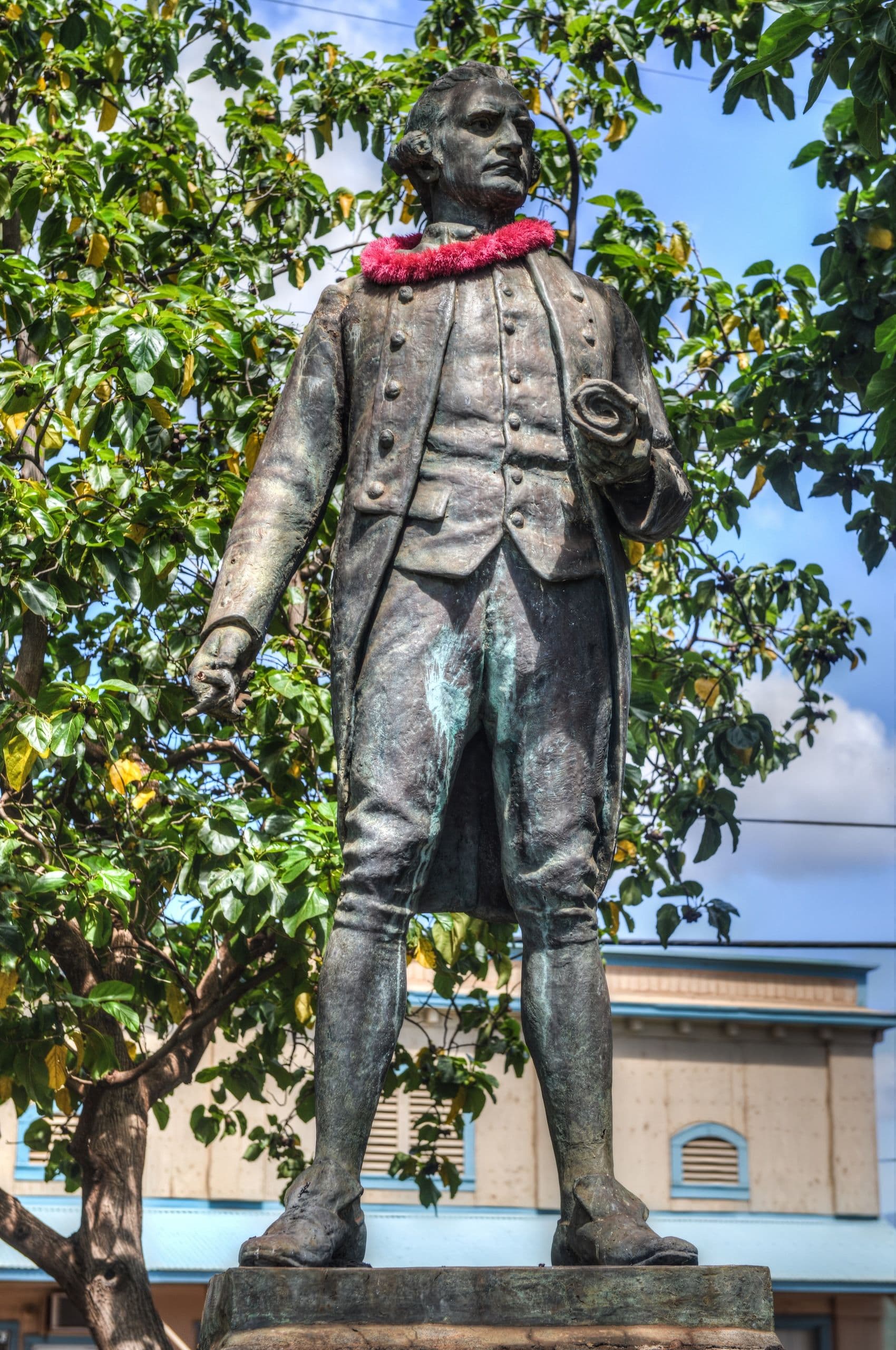By Hawaii.com Team
Kealakekua Bay on the Big Island of Hawaiʻi is where history and nature collide. It’s not only the site where British explorer Captain James Cook met his end, but it’s also considered one of Hawaiʻi’s best snorkeling locations, known for crystal-clear waters, vibrant coral reefs, and marine life like dolphins, manta rays and tropical fish.
Whether you’re a history buff or an ocean lover, snorkeling at Kealakekua Bay is an experience you won’t forget.
Captain James Cook, the British explorer credited with being the first Westerner to chart the Hawaiian Islands, first spotted Oʻahu and Kauaʻi on January 18, 1778. Two days later, he anchored his ship in Waimea Bay off Kauaʻi.
Nearly a year later, on January 17, 1779, Cook arrived at Kealakekua Bay on the Big Island during the Hawaiian Makahiki Festival, a celebration honoring the fertility god Lono. Because of the festival’s religious significance and Cook’s coincidental timing, the Hawaiians initially welcomed him as a god and held a large feast in his honor.
However, when Cook returned unexpectedly a week later after a storm-damaged ship forced him back, the mood shifted. The Hawaiians had realized he was not a deity, and tensions escalated. On February 14, 1779, during a skirmish near Kaʻawaloa Village, Captain Cook and four of his men were killed.
Today, a 27-foot white obelisk — the Captain Cook Monument — stands at the site of his death, erected in 1874 by the British government.

Statue of Captain James Cook in Waimea on Hawaiʻi Island. The statue of commemorates his first contact with the Hawaiian Islands on January 1778. Courtesy of Shutterstock. Photo by Felix Lipov.
Beyond its historic importance, Kealakekua Bay is a marine sanctuary protected by the state of Hawaiʻi. It offers some of the best snorkeling in the islands, thanks to:
Exceptional water clarity
Calm bay conditions
Healthy coral reefs
Frequent dolphin sightings
Abundant tropical fish species
It’s part of the Kealakekua Bay State Historical Park and is a designated Marine Life Conservation District, making it a protected area for marine biodiversity.
There are three main ways to access the snorkeling area near the monument:
Boat tours depart from Kailua-Kona or Keauhou Bay and provide direct access to the waters in front of the Captain Cook Monument.
Adventurous travelers can kayak across the bay, but note: a permit from the state is required, and landings are limited to reduce environmental impact.
This moderately difficult trail descends 1,300 feet to the shoreline. It’s a great option for hikers, but keep in mind you must carry your gear in and out, and there are no facilities at the beach.
Here are highly rated tour operators offering snorkeling trips to Kealakekua Bay and the Captain Cook Monument:
Departing From: Keauhou Bay
Highlights: Spacious catamarans, waterslides, onboard lunch
Why Choose Them: Great for families and first-timers
Book Fair Wind Cruises Snorkeling Tour
Departing From: Keauhou Bay
Highlights: Small group zodiac boats, cave exploration
Why Choose Them: More intimate, adventurous experience
Book Sea Quest Hawaii Snorkeling Tour
Departing From: Honokōhau Harbor
Highlights: Dolphins, sea caves, snorkeling at Captain Cook Monument
Why Choose Them: High-speed, exciting, great marine guides
Book Captain Zodiac Raft Snorkeling Tour
Services: Kayak rentals, guided kayak tours (with permits)
Why Choose Them: Ideal for eco-conscious travelers who want a quiet paddle across the bay
Book Kona Boys Kayak Snorkeling Tour
Kealakekua Bay is home to a wide array of marine life and coral species, including:
Parrotfish
Yellow tang
Butterflyfish
Spinner dolphins
Moray eels
Manta rays (less common but possible)
Sea urchins and starfish
Vibrant coral gardens
Note: The best snorkeling is in front of the Captain Cook Monument, along the northern shoreline, where underwater visibility can exceed 100 feet.
Respect the reef – Do not step on or touch coral.
Get permits if kayaking on your own.
Bring reef-safe sunscreen to protect marine life.
No public facilities at the monument — bring water, snacks and pack out your trash.
Wear sturdy shoes if hiking in or out.
Yes — it’s considered one of the top snorkeling spots in Hawaiʻi for water clarity and biodiversity.
Not necessarily. You can hike or kayak (with a permit), but most people choose guided snorkeling tours for ease and access.
The 2-mile trail is steep, rocky, and hot — suitable for moderately fit hikers. Going down is easy; coming back up is a workout.
Morning hours (before 11 a.m.) offer the calmest waters and best visibility. Afternoon conditions may get windier.
Whether you’re drawn by the history of Captain James Cook, the breathtaking underwater scenery, or the chance to snorkel with dolphins and tropical fish, Kealakekua Bay is a must-visit on the Big Island.
With easy tour access, incredible marine life, and one of the most fascinating stories in Hawaiian history, it’s no wonder this bay continues to captivate visitors from around the world.
Join our newsletter for travel inspiration, insider tips and the latest island stories.
By subscribing, you agree to receive emails from Hawaii.com. You can unsubscribe anytime. See our Privacy Policy.